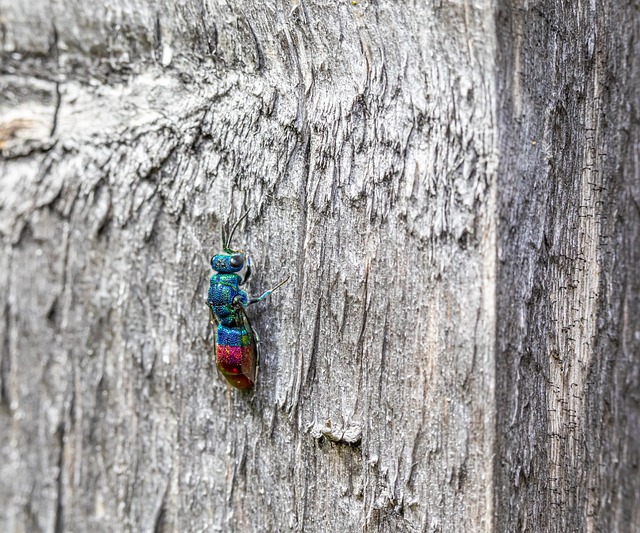Wasp behaviors and habitats are key factors in developing customized wasp control plans. By understanding natural cycles, preferences (e.g., sweet substances, water sources), nest locations, and site-specific characteristics, professionals can tailor prevention strategies for success. These customized wasp control plans involve removing food sources, sealing entry points, and using specialized traps or insecticides. Regular monitoring is crucial to assess effectiveness, adjust strategies, and prevent re-infestation, ensuring dynamic protection for homes or commercial spaces.
“Discover effective strategies for long-term wasp prevention with custom-tailored plans. This comprehensive guide explores the intricate world of wasp behaviors and habitats, offering a site-specific assessment for precise targeting. Learn how to design targeted prevention strategies tailored to your unique environment.
From implementation to monitoring, every step ensures optimal results. Embrace the power of customized wasp control plans to create a peaceful outdoor haven, free from these persistent intruders.”
Understanding Wasp Behaviors and Habitats
Wasp behaviors and habitats play a crucial role in developing effective customized wasp control plans. Understanding their natural cycles and preferences is essential for successful prevention strategies. Wasps are often attracted to sweet substances, so eliminating accessible food sources like overripe fruit and sugar-based products around your property can significantly deter them. They also have a keen eye for water, so maintaining dry areas, especially in damp environments, can help reduce their presence.
Knowing where wasps nest and build their habitats is vital. Some species prefer secluded spots like tree hollows or under eaves, while others may opt for more open areas such as ground nests. Identifying these locations allows for targeted treatments and regular monitoring, ensuring that any new wasp activity is quickly addressed. This knowledge-driven approach forms the backbone of successful long-term customized wasp control plans.
Developing a Site-Specific Assessment
When developing long-term wasp prevention strategies, a site-specific assessment is paramount to crafting effective customized wasp control plans. This involves meticulously examining the unique characteristics of each location, including the types of wasps prevalent in the area, their behavior patterns, and the specific attractants that draw them. For instance, certain wasp species might be more attracted to sweet fermentations or protein-rich substances found in outdoor kitchens or gardens. Understanding these factors enables specialists to tailor solutions accordingly, ensuring targeted and efficient control measures.
A thorough assessment also considers the structural elements of the site, such as nearby water sources, potential nesting sites, and the overall habitat. By integrating this knowledge with environmental considerations like seasonal variations and climate change impacts, experts can design robust plans that adapt over time. Consequently, these site-specific assessments form the cornerstone for successful, long-lasting wasp management strategies, ensuring a safer and more comfortable living environment.
Designing Tailored Prevention Strategies
When dealing with wasps, one-size-fits-all approaches rarely work effectively. That’s why designing tailored prevention strategies is key to achieving long-term success in wasp control. Customized plans consider specific wasp behaviors, habitat preferences, and environmental factors unique to each location.
By assessing the nature of the wasp infestation, professionals can implement targeted measures like eliminating food sources, sealing entry points, and using specific types of traps or insecticides. These personalized strategies not only mitigate wasp presence but also minimize the impact on non-target species and the environment, making them a more sustainable and effective solution for long-term wasp prevention.
Implementing and Monitoring Customized Plans
Implementing and monitoring customized wasp control plans is a multifaceted approach that requires both precision and adaptability. Once tailored strategies are put in place, regular inspections become paramount to assess their effectiveness. This involves meticulously observing wasp behavior, identifying potential entry points, and analyzing the overall health of treated areas. By combining these observations with environmental factors, professionals can adjust plans accordingly, ensuring optimal results over the long term.
Effective monitoring further enables proactive measures. If signs of re-infestation emerge, swift action can be taken to address them before they escalate. This dynamic process ensures that customized wasp control plans remain dynamic and responsive, providing lasting protection for homes or commercial spaces.
Customized wasp control plans, informed by a deep understanding of wasp behaviors and site-specific assessments, offer the most effective long-term solutions. By tailoring prevention strategies to unique habitats and environments, we can significantly reduce wasp populations and minimize their impact. Regular implementation and monitoring ensure these plans remain dynamic and responsive to changing conditions, providing a sustainable and efficient approach to wasp management.
